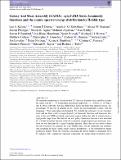Galaxy And Mass Assembly (GAMA) : ugrizYJHK Sersic luminosity functions and the cosmic spectral energy distribution by Hubble type
Abstract
We report the morphological classification of 3727 galaxies from the Galaxy and Mass Assembly survey with Mr < −17.4 mag and in the redshift range 0.025 < z < 0.06 (2.1 × 105 Mpc3) into E, S0-Sa, SB0-SBa, Sab-Scd, SBab-SBcd, Sd-Irr and little blue spheroid classes. Approximately 70 per cent of galaxies in our sample are disc-dominated systems, with the remaining similar to ~30 per cent spheroid dominated. We establish the robustness of our classifications, and use them to derive morphological-type luminosity functions and luminosity densities in the ugrizYJHK passbands, improving on prior studies that split by global colour or light profile shape alone. We find that the total galaxy luminosity function is best described by a double-Schechter function while the constituent morphological-type luminosity functions are well described by a single-Schechter function. These data are also used to derive the star formation rate densities for each Hubble class, and the attenuated and unattenuated (corrected for dust) cosmic spectral energy distributions, i.e. the instantaneous energy production budget. While the observed optical/near-IR energy budget is dominated 58:42 by galaxies with a significant spheroidal component, the actual energy production rate is reversed, i.e. the combined disc-dominated populations generate similar to ~1.3 times as much energy as the spheroid-dominated populations. On the grandest scale, this implies that chemical evolution in the local Universe is currently largely confined to mid-type spiral classes like our Milky Way.
Citation
Kelvin , L S , Driver , S P , Robotham , A S G , Graham , A W , Phillipps , S , Agius , N K , Alpaslan , M , Baldry , I , Bamford , S P , Bland-Hawthorn , J , Brough , S , Brown , M J I , Colless , M , Conselice , C J , Hopkins , A M , Liske , J , Loveday , J , Norberg , P , Pimbblet , K A , Popescu , C C , Prescott , M , Taylor , E N & Tuffs , R J 2014 , ' Galaxy And Mass Assembly (GAMA) : ugrizYJHK Sersic luminosity functions and the cosmic spectral energy distribution by Hubble type ' , Monthly Notices of the Royal Astronomical Society , vol. 439 , no. 2 , pp. 1245-1269 . https://doi.org/10.1093/mnras/stt2391
Publication
Monthly Notices of the Royal Astronomical Society
Status
Peer reviewed
ISSN
0035-8711Type
Journal article
Collections
Items in the St Andrews Research Repository are protected by copyright, with all rights reserved, unless otherwise indicated.
Related items
Showing items related by title, author, creator and subject.
-
SDSS-IV MaNGA: How the stellar populations of passive central galaxies depend on stellar and halo mass
Oyarzún, Grecco A.; Bundy, Kevin; Westfall, Kyle B.; Tinker, Jeremy L.; Belfiore, Francesco; Argudo-Fernández, Maria; Zheng, Zheng; Conroy, Charlie; Masters, Karen L.; Wake, David; Law, David R.; McDermid, Richard M.; Aragón-Salamanca, Alfonso; Parikh, Taniya; Yan, Renbin; Bershady, Matthew; Sánchez, Sebastián F.; Andrews, Brett H.; Fernández-Trincado, José G.; Lane, Richard R.; Bizyaev, D.; Boardman, Nicholas Fraser; Lacerna, Ivan; Brownstein, J. R.; Drory, Niv; Zhang, Kai (2022-07-06) - Journal articleWe analyze spatially resolved and co-added SDSS-IV MaNGA spectra with signal-to-noise ratio ∼100 from 2200 passive central galaxies (z ∼ 0.05) to understand how central galaxy assembly depends on stellar mass (M*) and halo ... -
Secular-and merger-built bulges in barred galaxies
Mendez Abreu, Jairo; Debattista, V. P.; Corsini, E. M.; Aguerri, J. A. L. (2014-12) - Journal articleContext. Historically, galaxy bulges were thought to be single-component objects at the center of galaxies. However, this picture is now questioned since different bulge types with different formation paths, namely classical ... -
Galaxy And Mass Assembly (GAMA) : galaxy close pairs, mergers and the future fate of stellar mass
Robotham, A. S. G.; Driver, S. P.; Davies, L. J. M.; Hopkins, A. M.; Baldry, I. K.; Agius, N. K.; Bauer, A. E.; Bland-Hawthorn, J.; Brough, S.; Brown, M. J. I.; Cluver, M.; De Propris, R.; Drinkwater, M. J.; Holwerda, B. W.; Kelvin, L. S.; Lara-Lopez, M. A.; Liske, J.; Lopez-Sanchez, A. R.; Loveday, J.; Mahajan, S.; McNaught-Roberts, T.; Moffett, A.; Norberg, P.; Obreschkow, D.; Owers, M. S.; Penny, S. J.; Pimbblet, K.; Prescott, M.; Taylor, E. N.; van Kampen, E.; Wilkins, S. M. (2014-11-11) - Journal articleWe use a highly complete subset of the Galaxy And Mass Assembly II (GAMA-II) redshift sample to fully describe the stellar mass dependence of close pairs and mergers between 10(8) and 10(12)M(circle dot). Using the analytic ...

